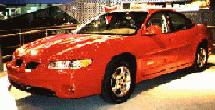

By Steven D. Gatt, Automotive Editor
The 1997 Pontiac Grand Prix GTP is a great sports sedan. It has all of the required elements: high style, excellent thrust, big interior, technical gadgetry and best of all an economical price. The Grand Prix we drove had almost every option, but the one drivers were most impressed and surprised by was the heads-up 'eyecue' display.
The heads-up display (HUD) beams holographically the speedometer, turn indicators, radio frequency or CD number and track onto the windshield so that the driver has no need to take their eyes off the road. The first question about the HUD was, "Is it distracting?". The answer is yes, and then no. At first, one is like a moth to a flame, drawn in by the new feature. Once becoming used to the HUD, it becomes second nature. You don't really notice it except when you actually look at the numbers. The numbers displayed by the HUD appear on the windshield, but low enough not to effect your field of vision. The HUD is a great feature, one that should be on more vehicles, as a safety item. It should also display if the speed-control is engaged.
The interior of the Grand Prix is very comfortable. It easily allows four adults to stretch out in comfort, adding a third person to the back seat only reduces comfort minimally. The driver is truly pampered in this car; not only with the HUD but steering wheel controls for the radio and ventilation systems. Once you're used to having buttons on the steering wheel, you really miss them when they're gone, in other cars. Further pampering only the driver, is a heated seat; passengers actually complained that their seats weren't heated. All of the interior seats feature leather surfaces; the driver and front passenger get power lumbar support.
The on-board diagnostic systems are highly sophisticated. Included in the Drivers Information Center are monitors for: open trunk lid and doors, supercharger boost gauge, low washer fluid, oil life, and even tire pressure sensors. The tire pressure sensors work through the anti-lock brake system. The system monitors the rotational radius of the tire, when more than 8 psi is lost in any given tire, the low pressure warning is displayed. As a tire loses pressure the rotational radius decreases. Also included in the computer was information about fuel economy and distance until empty.
The trunk was large and most of all long. Even if an item was too long to fit in the trunk there is a convenient pass-through for 2 X 4's, skis or any other long item. The pass-through converted to a storage bin, armrest and cupholders for the rear seat passengers. Also notable about the trunk was the compact disc changer that was mounted there. The 12-disc changer in conjunction with the rest of the stereo equipment made a great sound system, just adding to the reasons we like this car.
The exterior styling is excellent; the C-pillar is extremely narrow and the front end is very aggressive. One must be close to the car to see the many subtle curves. The Grand Prix, just like the Oldsmobile Aurora and Ford Taurus, has hips giving it sex appeal.
The powertrain is the 3800 Series II, supercharged V6 that I've sung the praises of many times before. It has 240 hp, more than the current Mustang GT. The supercharged engine gives an almost instantaneous responsiveness to the throttle of the Grand Prix. Test results from Car and Driver, August 1996, show that it only takes 6.8 seconds to reach 60 mph, quick for a sedan weighting 3,480 lbs. The suspension is good, although I think it should be tighter on the GTP model. During our evaluation the car had a tendency to push too often in tight corners.
The base price for the Pontiac Grand Prix GT sedan is $19,809. Adding in the GTP option package, sunroof, chrome wheels, leather seats, CD changer, and destination brings one to a total as-tested price of $25,422. The 25-grand might sound expensive, but this car was absolutely loaded. A comparably equipped Taurus SHO could cost $28,000.
Mileage ratings from the EPA are 18 mpg city and 28 mpg highway. We achieved 23.3 mpg during our two week test drive. Under normal circumstances, one can get better mileage ratings from this car, but we had a lot of fun.
Unfortunately, the evaluated car had one defect from the factory. The driver's side rear door was squeaky; two pieces of insulation were loose and rubbing together. You can just imagine the white noise it created over bumpy roads. In my opinion this is a minor defect, and forgivable if the dealership takes care of it the first time. Considering its value, performance, styling and roominess the 1997 Grand Prix GTP is the best sport sedan on the market today.